Date: January 17, 2024
A bilingual Webinar in English and Hindi was organised by Renaissance Journal Team on the theme of ‘Sri Rama in Indian Consciousness – Bharatiya Chetana Mein Sri Ram’ on 17th January, 2024. The whole webinar was conducted in a spirit of “Satsang” and with an aim to highlight in the light of Sri Aurobindo the significant place Sri Rama holds in the Indian cultural psyche and consciousness.
The panelists included: Dr Beloo Mehra, Editor of Renaissance Journal; Dr Charan Singh Kedarkhandi, a poet, educator, spiritual seeker from Joshimath, Uttarakhand; Mr. Narendra Murty, author, content creator and Renaissance author and team-member; and Ms. Bindu Popli, artist, illustrator and educator from New Delhi.
WATCH RECORDING HERE

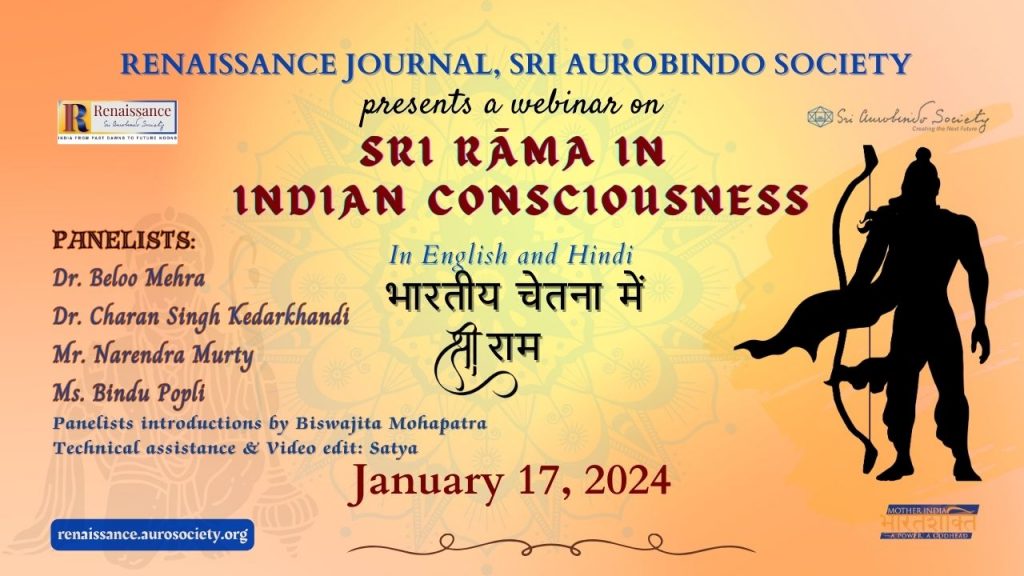
The webinar opened with some brief introductory remarks from Dr. Beloo Mehra who highlighted the spirit in which the webinar was organized and focused on how India is currently going through an important turning point as well as deep churning in her civilizational history. Ms. Biswajita Mohapatra, Renaissance team-member and moderator for the session, then briefly introduced the first speaker, Dr. Mehra.
For some part of the webinar, Shri Pradeep Narang, Chairman, Sri Aurobindo Society also joined. But due to some technical difficulties he could not stay for the whole programme.
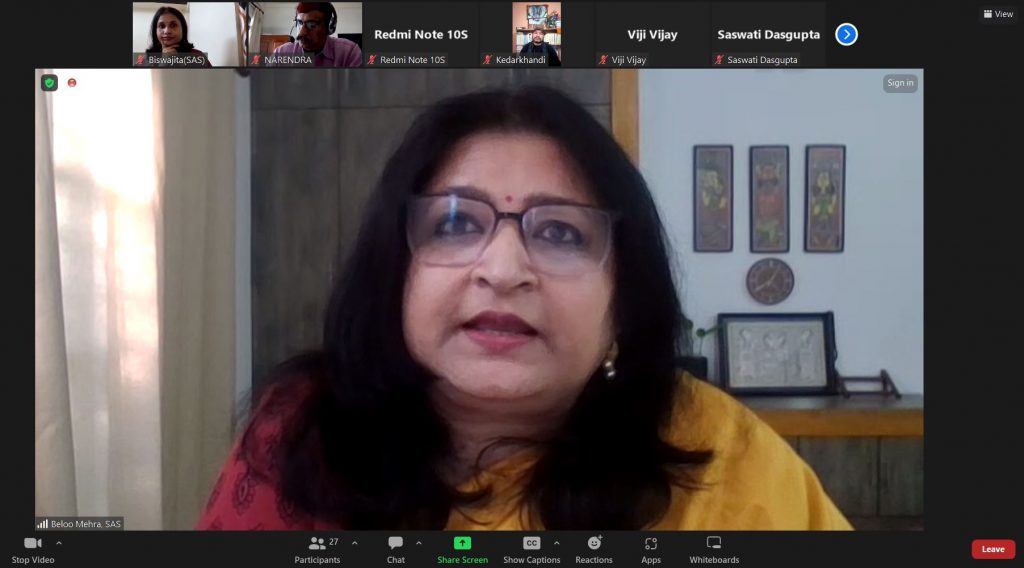
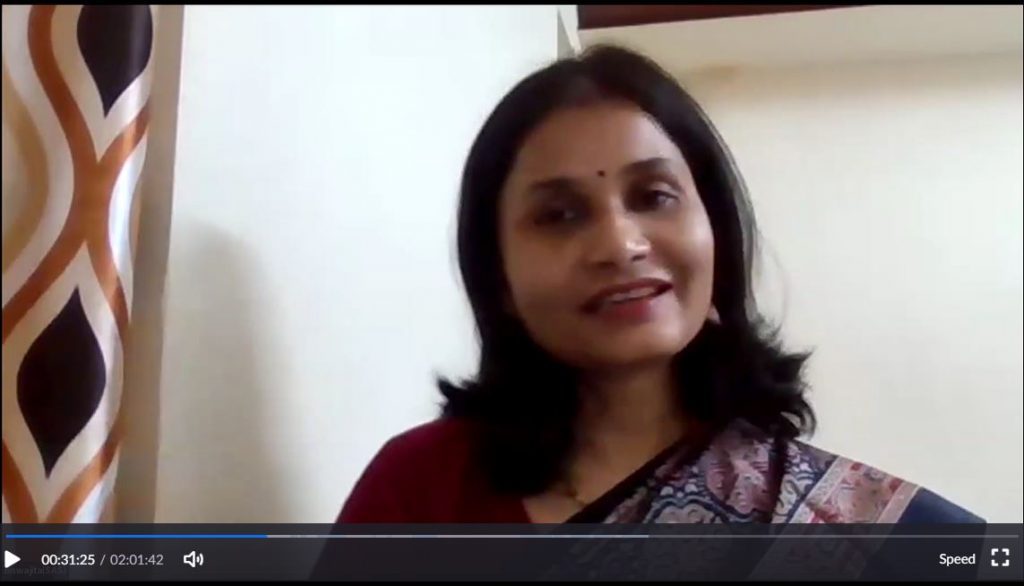
Dr. Mehra took up the topic – “How Sri Aurobindo Deepened my Love for Sri Ram”. Building upon her introductory comments, Dr Mehra started off her comments with a few words on the importance of Sri Ram in India’s ongoing cultural renaissance and spiritual evolution. Then she spoke about how her love for Sri Rama was initially ignited by her father who used to read from Sant Tulsidas’ Ramcharitmanas. She said how later in the writings of Sri Aurobindo she learnt how the modern mind tries to interpret the life and work of an Avatar purely from the point of view of biography and history – laying the emphasis entirely on the external aspects of the Avatar and totally ignoring the internal and spiritual purpose for which the Avatar had come.
She reminded that it is important to recall what Sri Aurobindo said about entering into the “time spirit” of that age without which we cannot really understand the work of that Avatar. Also, we should try to appreciate the grand character of Rama that has been immortalised by Valmiki and not be too carried away by our rational questioning and focusing on the perceived shadows in that character.
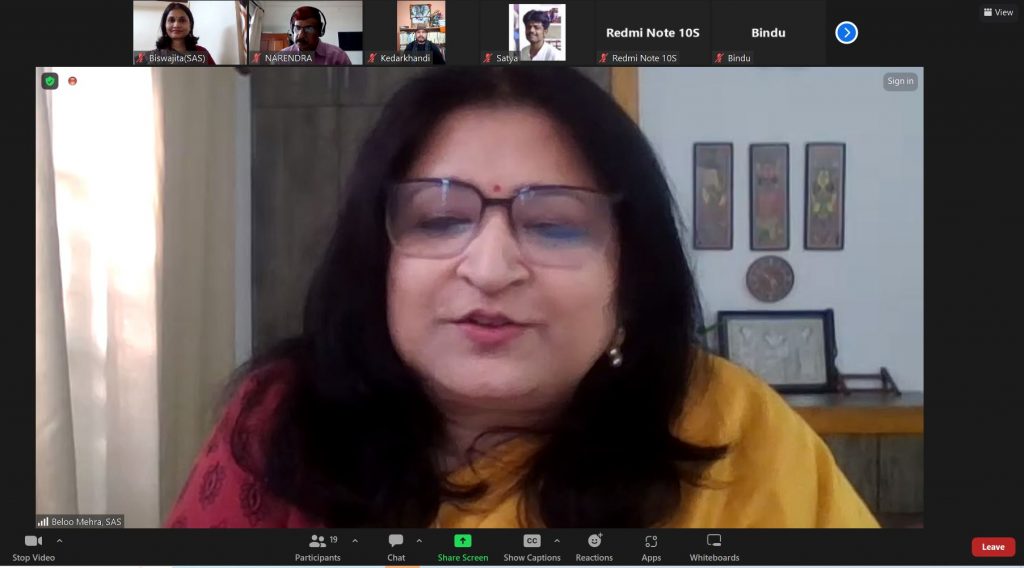
Dr. Mehra also mentioned that Sri Aurobindo pointed out that how a devotee would perceive Rama would depend on his own temperament. And it was the purpose of Rama as an avatar to establish the Sattwic mentality in the evolutionary rung of consciousness, to establish public and social order, to conquer the Rajasic and Tamasic nature as expressed in the Rakshasa and the animal mind. Moreover, by Sattwic it is meant that it was predominantly the mental man rather than the vital or physical man. This is what she highlighted from the writings of Sri Aurobindo about the nature of Sri Ram’s work.
After a brief introduction of the next speaker by Ms. Biswajita Mohapatra, Dr Charan Singh Kedarkhandi spoke in Hindi on the topic – “Tulsi ke Sri Ram”. He said that the greatest contribution of Tulsidas was to take Sri Ram to the common man and into every household; to the door of every rustic. The Ramcharitmanas of Tulsidas is a retelling in Avadhi language of the Sanskrit classic of Valmiki. The fact that today Rama resides in the heart of every Indian is the result of the tapasya of Tulsidas. He said that Tulsidas focused on the character and deeds of Sri Ram so that they could become an example for the society. Hence more than 10000 verses of Ramcharitmanas are devoted to this behavioural aspect of Sri Ram.
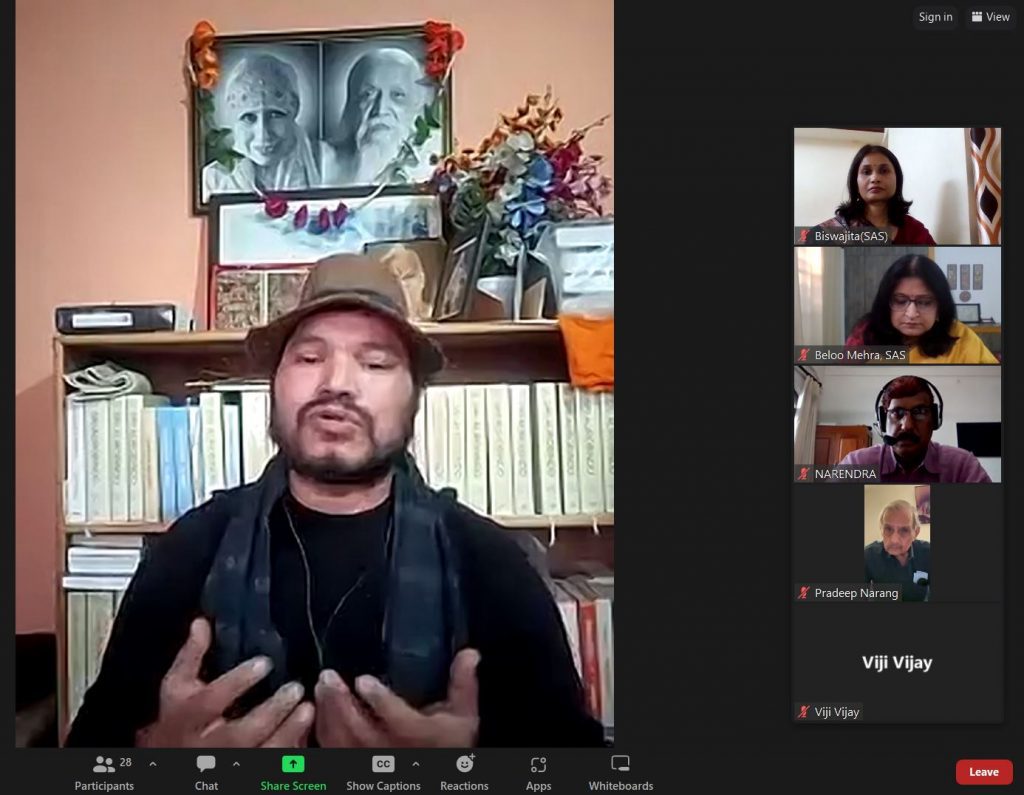
Dr. Charan Singh also recited a couple of verses from it and cadence of Tulsidas delighted the participants. He concluded his presentation stating how Tulsidas has brought out all the facets of Ram’s character by showing how he behaved with everyone – as a warrior, a king, a husband, a brother etc. He emphasised that every verse of Ramcharitmanas is a lesson on propriety, rectitude and Maryada. It is a moral pillar and mirror for Indian society. When confronted by trials and tribulations, Ramcharitmanas shows us how we should behave keeping the shining example of Ram in our minds for he too faced innumerable challenges throughout his life. Dr. Charan Singh highlighted that Sant Tulsidas had written the Ramcharitmanas inspired by the blessings of Lord Shiva and for self-illumination. He concluded by quoting a verse that said in Kaliyug, neither Yoga, nor meditation nor knowledge – but the power of Sri Ram is our redemption.
Ms. Mohapatra then invited the next speaker Mr. Narendra Murty and read out his brief introduction. Mr. Murty spoke on the topic of “The Avataric Work of Sri Ram”. He began by speaking about Parashuram and in what way he corrected the excesses committed by the Kshatriya class. But the balance had to be restored within the Kshatriya class by throwing a blazing light on what an ideal, perfect Kshatriya role model should be like. It was not enough to say that the Kshatriya should be chivalrous, noble, protector of the weak etc. A role model had to be set up. That was the purpose of Rama avatar. The spirt of the times was full of the Rajasic and Tamasic mentality as represented by the Vanara and Rakshasa. Sri Rama brings in the next step in the human evolution: the Sattvic man.
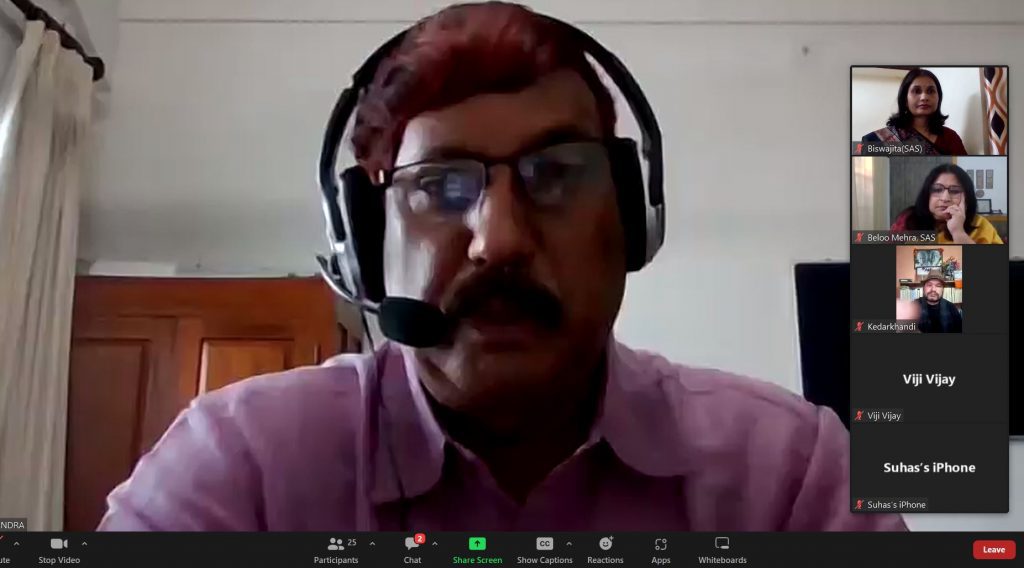
Mr. Murty said that while setting up a perfect standard for a certain role, Valmiki did not balance it with pragmatism. The role had to be perfect even if that compromised the overall personality of Rama. There could be no dilution in the perfection of each role that was conceived. Using this standard, if we judge Rama, we would always find him to be perfect. What should a son be like? Like Rama. What should a king be like? Like Rama. What should a husband be like? Like Rama. So, in all these individual roles Rama excels. When he sent away his wife into exile, he was playing the perfect king he paid heed even to a lone voice in the kingdom. We human beings are a mixture of perfection and imperfections; but Rama in his individual roles is always perfect. Sri Aurobindo said that an Avatar is “the attracting divine example given by God to man”. Sri Aurobindo also wrote that “figure of Rama has been stamped on the mind of Indian culture for two millenniums and would continue to do so till a greater ideal arises”.
After Ms. Mohapatra invited and introduced the final speaker for the event, Ms Bindu Popli spoke on the topic of “An Artist’s Love for Sri Ram”. At the very outset she spoke about the greatness and vastness of Sri Ram and how difficult it is to catch him in forms and pictures. She also spoke of her fascination by the figure of Hanuman. Thereafter, her paintings and illustrations inspired by the stories of Rama, Hanuman and various scenes from the Ramayana were displayed on the screen in the form of a short video. She felt that the name of “Ram” is greater than Ram himself because so many people have been redeemed just by chanting the name of Ram even though they could not be in his physical presence.
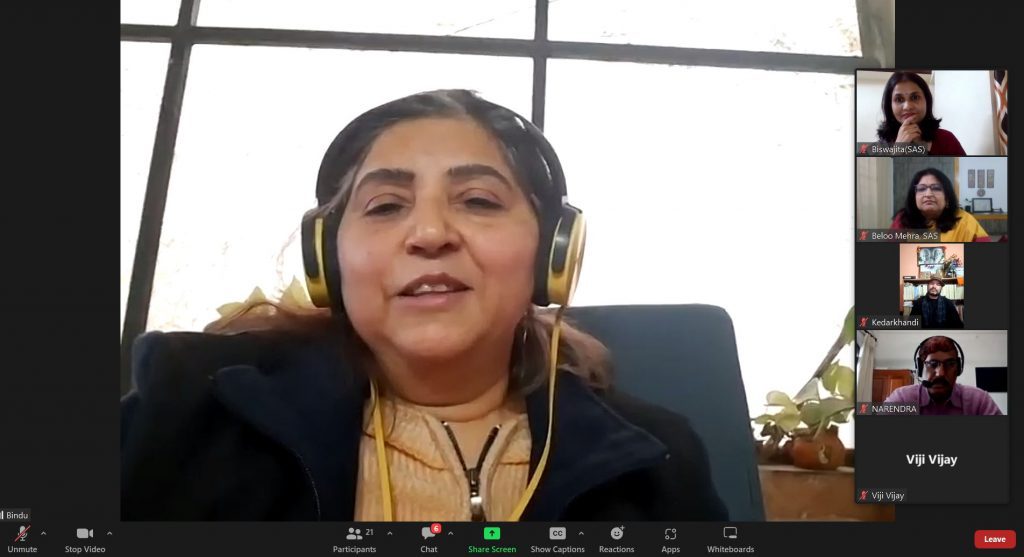
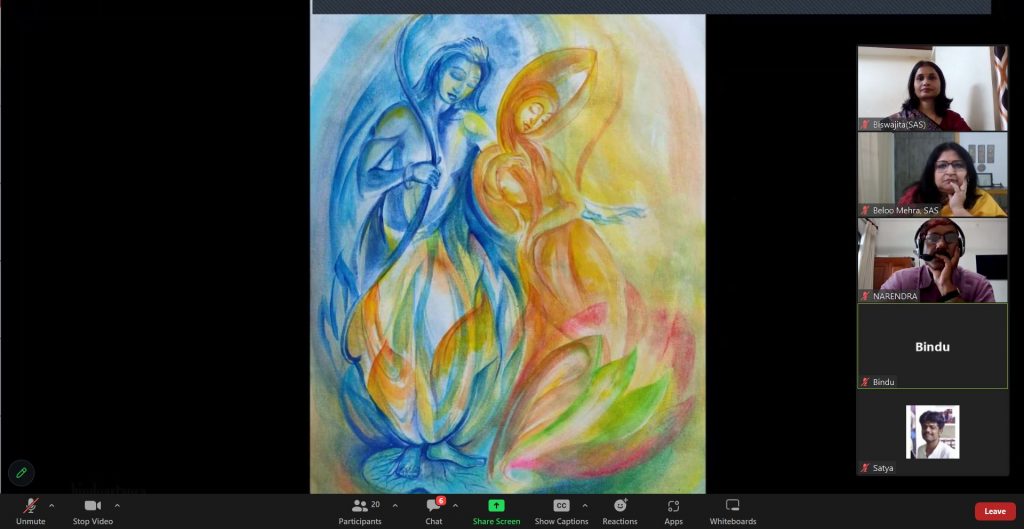
After the speakers’ sessions, several questions from the participants were taken up. The panellists responded with their views and insights, and the interactions were enlightening and engaging for all. The webinar went on for 2 hours holding the attention of everyone present.
About the panelists:
Dr Beloo Mehra – Senior Academic Mentor, and Editor of Renaissance Journal, Sri Aurobindo Society. She worked as a professor in the US for more than a decade before she moved to Pondicherry in 2007 to focus on Sri Aurobindo Studies. She writes and speaks regularly on topics related to Sri Aurobindo’s and the Mother’s vision and works on Indian culture, Education, Social philosophy and Yoga. She is currently also teaching a post-graduate course at Pondicherry University on Social Philosophy of Sri Aurobindo.
Dr Charan Singh Kedarkhandi – poet, thinker, spiritual seeker and a student of the Indian knowledge tradition. He lives and works in Jyorimath, Uttarakhand. Widely respected as an authority on Sri Aurobindo’s poetry, yoga and philosophy, Dr. Kedarkhandi writes and speaks about the spiritual vision of the Mother and Sri Aurobindo. He is the founder member of Sri Aurobindo Study Centre, Jyotirmath (Uttarakhand) and also edits the centre’s annual bilingual magazine Anukampa, the Grace Divine. He writes frequently for Renaissance Journal.
Mr. Narendra Murty – Professionally, Narendra Murty worked as a Divisional Manager in LIC. However, the deep driving passion of his life has been the study of various religions and philosophies. He has authored four books on themes related to the spiritual quest. Presently he is devoted full time to his study and writing and working as Content Creator for Sri Aurobindo Society, Pondicherry and contributes every month to Renaissance Journal.
Ms. Bindu Popli – Bindu Popli creates art that comes from a place deep within her. She has a BFA degree in painting from Delhi College of Art where she received several prestigious awards and scholarships. She is currently heading the Art Department at a public school in Delhi. With a deepening of her inner journey, her art has increasingly become an expression the truth within her. She has been featured twice in the Insightful Conversations series for Renaissance.
